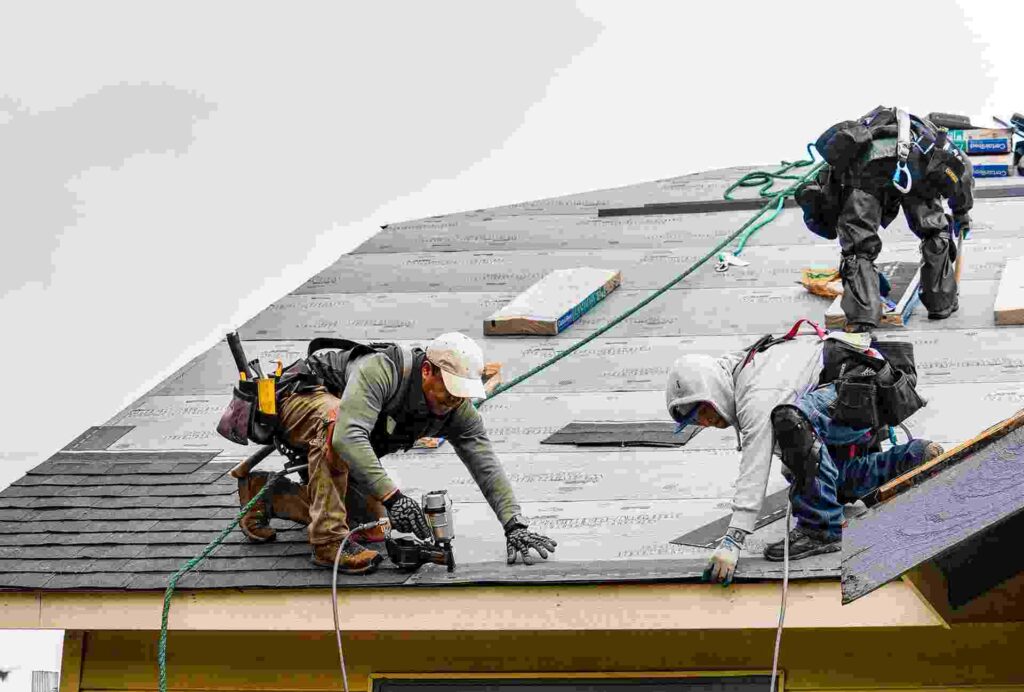Various types of storms can cause significant damage necessitating restoration efforts. Hurricanes, with their powerful winds and torrential rains, often lead to severe flooding and structural damage. Tornadoes, characterized by their intense, localized windstorms, can demolish buildings and uproot trees in minutes. Severe thunderstorms can bring heavy rain, hail, and lightning, resulting in water damage, shattered windows, and electrical fires. Winter storms, including blizzards and ice storms, can cause roof collapses, broken pipes, and widespread power outages due to heavy snow and ice accumulation. In this article, Angel Construction Broker LLC helps in understanding that each type of storm presents unique challenges, requiring specialized restoration to mitigate the damage and restore affected areas to their pre-storm conditions.
Thunderstorms
Thunderstorms are among the most common types of storms that can cause significant damage to property. These storms are characterized by the presence of lightning and thunder, often accompanied by heavy rainfall, strong winds, and hail. The combination of these elements can wreak havoc on buildings and landscapes. Lightning strikes can cause fires, damage electrical systems, and lead to power outages. Heavy rain can result in flooding, especially if drainage systems are overwhelmed. Wind gusts can tear off shingles, break windows, and uproot trees, while hail can dent vehicles, damage roofs, and break windows. The aftermath of a thunderstorm often requires a comprehensive restoration process that includes water damage mitigation, roof repair, and electrical system inspections. Effective storm restoration services are essential to quickly and efficiently address the aftermath of a thunderstorm.
Tornadoes
Tornadoes are highly destructive windstorms that can cause severe damage in a matter of minutes. Characterized by a rotating column of air that extends from a thunderstorm to the ground, tornadoes have wind speeds that can exceed 300 miles per hour. This intense wind power can demolish buildings, lift vehicles, and uproot trees. The damage caused by tornadoes is often extensive and requires a multifaceted restoration approach. Structural repairs are typically needed for buildings, and fallen trees and debris must be cleared. Additionally, utilities such as electricity, gas, and water often need to be inspected and repaired to ensure safety. Restoration after a tornado is a complex process that often involves multiple contractors and can take several months to complete.
Hurricanes and Tropical Storms
Hurricanes and tropical storms are large, organized systems of wind and rain that can cause widespread damage over large areas. These storms bring a combination of strong winds, heavy rain, storm surges, and flooding. Wind damage from hurricanes can tear off roofs, break windows, and topple trees and power lines. Heavy rain can cause severe flooding, especially in low-lying areas, leading to water damage in homes and buildings. Storm surges, which are rises in sea level caused by the storm’s winds, can inundate coastal areas and cause extensive damage to infrastructure and property. Restoration after hurricanes and tropical storms often involves water extraction, drying and dehumidification, mold remediation, structural repairs, and debris removal. Storm restoration services for these types of storms are comprehensive, addressing various forms of damage caused by high winds, heavy rain, and storm surges.
Blizzards and Winter Storms
Blizzards and winter storms bring a combination of heavy snowfall, strong winds, and freezing temperatures. These conditions can lead to a range of damages that require restoration efforts. Heavy snow can accumulate on roofs, causing them to collapse under the weight. Ice accumulation on roofs can lead to ice dams, which can prevent melting snow from draining properly and cause water to seep into buildings. Strong winds can bring down trees and power lines, leading to power outages and physical damage to structures. Additionally, the freezing temperatures can cause pipes to burst, resulting in water damage inside buildings. Restoration after a winter storm often involves snow and ice removal, roof repair, tree and debris removal, and addressing water damage caused by burst pipes.
Hailstorms

Hailstorms can cause significant damage to property, particularly to roofs, windows, and vehicles. Hailstones can range in size from small pellets to large balls, and when they fall at high speeds, they can dent vehicles, break windows, and damage roofs and siding. Roofs are particularly vulnerable to hail damage, as the impact can cause shingles to crack, break, or become dislodged, leading to leaks and water damage inside the building. Windows and siding can also be cracked or shattered by large hailstones. Vehicles left outside during a hailstorm can suffer dents, broken windows, and other damages. Restoration after a hailstorm typically involves roof installation and repairs, window replacement, and vehicle repair. In some cases, insurance claims are necessary to cover the cost of repairs.
Heavy Rain and Flooding
Heavy rain and flooding can cause extensive water damage to homes, businesses, and infrastructure. When the amount of rainfall overwhelms drainage systems, it can lead to water accumulation in basements, crawl spaces, and other low-lying areas. Floodwaters can bring in mud, debris, and contaminants, causing further damage to the property and posing health risks. Prolonged exposure to water can weaken structural components of buildings, cause mold growth, and damage personal belongings. Restoration after heavy rain and flooding involves several steps: water extraction, drying and dehumidification, cleaning and sanitizing, mold remediation, and repairing or replacing damaged structural elements and personal items. It’s crucial to address water damage promptly to prevent long-term issues and ensure the safety and stability of the affected property.
Windstorms
Windstorms, including events like derechos and straight-line winds, can cause significant damage to structures, vegetation, and infrastructure. Wind speeds in these storms can reach up to 100 miles per hour or more, leading to widespread destruction. Roofs can be torn off, siding can be ripped away, and windows can be shattered. Trees and large branches are often brought down by the force of the wind, causing additional damage to homes, vehicles, and power lines. Restoration after a windstorm typically involves securing damaged roofs and siding, removing fallen trees and debris, and repairing or replacing broken windows. Power restoration and electrical repairs are also common, especially if power lines are downed during the storm. Restoration professionals will inspect roofs, windows, doors, siding, and foundations to determine the extent of structural damage.
Wildfires
Although wildfires are not traditionally classified as storms, they are extreme weather events that can cause extensive damage requiring restoration. Wildfires can spread rapidly, fueled by dry conditions, high winds, and flammable vegetation. The intense heat and flames can destroy homes, commercial buildings, forests, and infrastructure. Smoke and soot can infiltrate buildings, causing air quality issues and additional damage to interior surfaces and belongings. Restoration after a wildfire involves several stages: assessing structural integrity, removing debris, cleaning and deodorizing affected areas, and repairing or rebuilding damaged structures. Specialized cleaning techniques are required to remove smoke odor and soot from surfaces, fabrics, and HVAC systems. Restoration professionals also focus on ensuring the property is safe for occupancy and addressing any environmental hazards created by the fire.
Ice Storms

Ice storms occur when rain falls and freezes upon contact with surfaces, leading to the accumulation of ice on roads, trees, power lines, and buildings. The weight of the ice can cause significant damage, such as roof collapses, fallen trees, and downed power lines. Branches and trees coated in ice can break and fall, damaging property and creating hazardous conditions. Power outages are common during ice storms as the weight of the ice brings down power lines and utility poles. Restoration after an ice storm involves several key steps: clearing ice and debris, repairing damaged roofs and structures, and restoring power. Electrical systems need to be inspected and repaired to ensure safety. Additionally, addressing water damage from melting ice and preventing mold growth are important aspects of the restoration process.
Severe Wind and Thunderstorms
Severe wind and thunderstorms can bring a combination of damaging winds, heavy rain, hail, and lightning, causing a wide range of damages that require restoration. High winds can tear off roofs, break windows, and topple trees and power lines. Heavy rain can lead to flooding and water damage, while hail can dent vehicles, damage roofs, and break windows. Lightning strikes can cause fires, damage electrical systems, and lead to power outages. Restoration efforts after severe wind and thunderstorms typically include onsite inspection, roof and window repairs, water damage mitigation, tree and debris removal. Ensuring structural integrity and addressing any fire or smoke damage from lightning strikes are also critical components of the restoration process.
Tropical Depressions and Tropical Storms
Tropical depressions and tropical storms, while generally less intense than hurricanes, can still cause significant damage, especially in coastal and low-lying areas. These storms bring heavy rainfall, strong winds, and the potential for flooding. Prolonged periods of heavy rain can overwhelm drainage systems, leading to water accumulation in basements, crawl spaces, and other vulnerable areas. Strong winds can damage roofs, break windows, and uproot trees, while storm surges can cause coastal flooding and damage to infrastructure. Restoration after tropical depressions and tropical storms involves water extraction, drying and dehumidification, mold remediation, and structural repairs. Ensuring proper drainage and preventing future flooding are important considerations during the restoration process. Additionally, repairing any wind damage to roofs, siding, and windows is essential to restore the property to its pre-storm condition.
Sandstorms and Dust Storms
Sandstorms and dust storms, common in arid and semi-arid regions, can cause damage that requires restoration, particularly to buildings, vehicles, and outdoor equipment. These storms are characterized by strong winds that lift and carry large amounts of sand and dust, reducing visibility and creating abrasive conditions. The sand and dust can infiltrate buildings, causing damage to interior surfaces, HVAC systems, and electronics. Prolonged exposure to these abrasive particles can wear down exterior surfaces, damage paint, and clog air filters and machinery. Restoration after a sandstorm or dust storm involves cleaning and removing sand and dust from interior and exterior surfaces, inspecting and cleaning HVAC systems, and repairing or replacing damaged equipment and machinery. Ensuring that buildings are properly sealed and protected from future storms is also an important aspect of the restoration process.
Conclusion:
In conclusion, the variety of storms—hurricanes, tornadoes, severe thunderstorms, and winter storms—can each inflict extensive damage that necessitates comprehensive restoration efforts. The unique nature of the destruction caused by each type of storm requires tailored approaches to effectively address and repair the damage. Rapid and efficient restoration not only mitigates the immediate impact but also helps communities recover and rebuild, ensuring safety and resilience against future storms. By understanding the specific challenges posed by different storms, restoration professionals can better prepare and respond, ultimately safeguarding lives and property.
